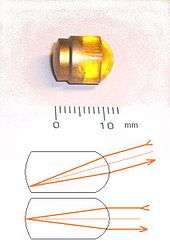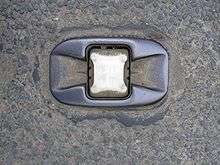Cat's eye (road)
A cat's eye or road stud is a retroreflective safety device used in road marking and was the first of a range of raised pavement markers.
Description

The cat's eye design originated in the UK in 1934 and is today used all over the world. The original form consisted of two pairs of reflective glass spheres set into a white rubber dome, mounted in a cast iron housing. This is the kind that marks the centre of the road, with one pair of cat's eyes showing in each direction. A single-ended form has become widely used in other colours at road margins and as lane dividers. Cat's eyes are particularly valuable in fog and are largely resistant to damage from snow ploughs.
A key feature of the cat's eye is the flexible rubber dome which is occasionally deformed by the passage of traffic. A fixed rubber wiper cleans the surface of the reflectors as they sink below the surface of the road (the base tends to hold water after a shower of rain, making this process even more efficient). The rubber dome is protected from impact damage by metal 'kerbs' – which also give tactile and audible feedback for wandering drivers.
History

The inventor of cat's eyes was Percy Shaw of Boothtown, Halifax, West Yorkshire, England. When the tram-lines were removed in the nearby suburb of Ambler Thorn, he realised that he had been using the polished strips of steel to navigate at night.[1] The name "cat's eye" comes from Shaw's inspiration for the device: the eyeshine reflecting from the eyes of a cat. (Comedian Ken Dodd later remarked, "If the cat had been facing the other way, he'd have invented the pencil sharpener.") In 1934, he patented his invention (patents Nos. 436,290 and 457,536), and on 15 March 1935, founded Reflecting Roadstuds Limited in Halifax to manufacture the items.[2][3] The name Catseye is their trademark.[4] The reflective lens had been invented six years earlier for use in advertising signs by Richard Hollins Murray, an accountant from Herefordshire[5][6] and, as Shaw acknowledged, they had contributed to his idea.[1]
The blackouts of World War II (1939–1945) and the shuttered car headlights then in use demonstrated the value of Shaw's invention and helped popularise their mass use in the UK. After the war, they received firm backing from a Ministry of Transport committee led by James Callaghan and Sir Arthur Young. Eventually, their use spread all over the world.
In 2006, Catseye was voted one of Britain's top 10 design icons in the Great British Design Quest organised by the BBC and the Design Museum, a list which included Concorde, Mini, Supermarine Spitfire, K2 telephone box, World Wide Web and the AEC Routemaster bus.[7][8]
Local practice
United Kingdom and Hong Kong
In the United Kingdom, different colours of cat's eyes are used to denote different situations:
- White is used to indicate the centre line of a single carriageway road or the lane markings of a dual carriageway.[lower-alpha 1]
- Red and amber cat's eyes denote lines that should not be crossed. Red is used for the left side of a dual carriageway, while amber is used for the right side of a dual carriageway.
- Green indicates a line that may be crossed, such as a slip road or lay-by.[9]
These units are not very visible in daylight and are generally used in conjunction with traditionally painted lines. Temporary cat's eyes with just a reflective strip are often used during motorway repair work. These are typically day glow green/yellow so they are easily visible in daylight as well as in darkness, they can then be used on their own for lane division.
Also seen during motorway repair work are plastic traffic pillars that are inserted into the socket of a retractable cat's eye rather than being free-standing. These are often used in conjunction with two rows of the temporary cat's eyes to divide traffic moving in opposite directions during motorway roadworks.
Solar-powered cat's eyes known as solar road studs and showing a red or amber LED to traffic, have been introduced on roads regarded as particularly dangerous at locations throughout the world.[10][11] However, shortly after one such installation in Essex in the autumn of 2006 the BBC reported that the devices, which flash at an almost imperceptibly fast rate of 100 times a second, could possibly set off epileptic fits and the Highways Agency had suspended the programme.[12] The suspension appeared to have been lifted by 2015, when LED cat's eyes began to be installed along newly re-paved sections of the A1 and A1(M) in County Durham and Tyne and Wear.
Flashing blue LED cat's eyes were demonstrated on the TV show Accident Black Spot, aired on Channel 4 on 19 December 2000, which alert the driver to potential ice on the road when a low enough temperature, provisionally set at 3 °C (37 °F), is reached. Proposed enhancements in 2013 were to change the standard white light to amber for four seconds after the passing of a vehicle, or red if the following vehicle is too close or traffic ahead is stationary.[13]
Ireland

In Ireland yellow cat's eyes are used on all hard shoulders, including motorways (neither red nor blue cat's eyes are used). In addition, standalone reflector batons are often used on the verge of Irish roads. Green cat's eyes are used to alert motorists to upcoming junctions. There are limited installations of actively powered cats eyes, which flash white light, on particularly dangerous sections of road such as the single carriageway sections of the N11.
United States
Botts' dots (research started 1953, compulsory in California from 1966) and other raised carriageway markers perform a similar function in areas of the United States that receive little snowfall. In areas of the US receiving substantial accumulating snowfall that requires the use of snow removal equipment, recessed markers or those encased in protective metal are frequently used.[14]
New Zealand
In New Zealand, roads are generally marked with both Botts' dots and cat's eyes (typically there is one cat's eye followed by three Botts' dots places in every ten-metre stretch of highway). The colour pattern on New Zealand roads is white or yellow cat's eyes along the centre of the road (yellow indicating overtaking is not permitted) and red dots along the hard shoulder or left edge of a motorway. Single blue cat's eyes are used to indicate the location of fire hydrants, and green cat's eyes are used to mark the edge of culverts. In rural settings and along State Highways, these markings are augmented by retroreflective posts along the edge of the road (white reflectors on the left, yellow reflectors on the right). Bridges are similarly marked with retroreflective markings in diagonal bands of white and black (to the left) and yellow and black (to the right).[15]
Continental Europe

By contrast to the UK where use of cat's eyes is widespread, in Continental Europe, cat's eyes are almost completely absent as a permanent fixture. Some road users, especially cyclists and motorcyclists, consider cat's eyes unnecessary as an additional lane or position marking identification and actually pose a threat to safety upon impact due to their prominent, slippery and unforgiving nature – particularly in the wet – and of their propensity to be located in close proximity to areas of increased hazard. It is also suggested that the additional emphasis of an already brightly visible and reflective painted lane marking is simply not required for any potential road event or condition. Many also consider that the absence of cat's eyes reduces the risk of physical and audible discomfort when driving, and that their benefits to safety are exaggerated.
Lebanon
In Lebanon, cat's eyes are widely used on most freeways, highways and roadways. On freeways and highways, every one (or sometimes two) white stripes separating lanes is followed by a white shining cat's eye. On the edge of the road next to the median strip, a yellow cat's eye is placed every 10 metres (33 ft). On the road shoulders a red shining cat's eye is placed every 10 metres (33 ft). On roadways separated by double yellow lines, a yellow cat's eye is placed inside the double yellow lines every 10 metres (33 ft). Before speed bumps, a series of cat's eyes are placed shining white to the oncoming traffic and red to the car from the opposite direction. On pedestrian crossings, blue shining cat's eyes are placed after every zebra line. On roads with traffic lights, a series of red shining cat's eyes are placed 50 metres (160 ft) before traffic lights to make drivers slow down.
Safety
In the morning of 25 April 1999 on the M3 motorway in Hampshire, England, a van dislodged the steel body of a cat's eye which flew through the windscreen of a following car and hit a passenger (the drum and bass DJ known as Kemistry) in the face, killing her instantly. The coroner recorded a verdict of accidental death.[16] Investigators acknowledged that the cat's eye bodies occasionally came loose, but added that such an accident was previously unheard of.[17] A question was asked in the House of Lords about the safety of cat's eyes in light of the incident, and the Highways Agency conducted an investigation into the "long-term integrity and performance" of various types of road stud.[18]
Notes
- 'Dual carriageway' includes motorways
References
- "The day Percy saw the light!". Halifax Today. Archived from the original on 12 March 2004. Retrieved 24 April 2013.
- "History". Reflecting Roadstuds Ltd. Archived from the original on 19 February 2009. Retrieved 24 April 2013.
- Reyburn, Ross (26 June 1999). "Inventions that prove size doesn't matter; Ross Reyburn takes a look at some of the little things that have changed lives in big ways over the century". The Free Library. The Birmingham Post. Retrieved 7 March 2020.
- The History of British Roadsigns, Department for Transport, 2nd Edition, 1999
- British patent 289619 7 April 1927
- United States patent 1625905 26 April 1927
- "Long list unveiled for national vote on public's favourite example of Great British Design". BBC. 18 November 2016.
- "Concorde voted the UK's top icon". BBC. 18 November 2016.
- "Chapter 5 - Road Markings". Traffic Signs Manual (PDF). London: The Stationery Office. 2018. p. 48. ISBN 978 0 11 553208 5. Archived from the original (PDF) on 15 December 2019. Retrieved 25 April 2020.
- "Case studies". Astucia Traffic Safety Systems. Archived from the original on 15 April 2012. Retrieved 13 October 2009.
- "Cats eyes to improve safety on A65, North Yorkshire". Government News Network. 6 November 2006. Archived from the original on 30 September 2007. Retrieved 15 March 2008.
- "New cat's eye 'could trigger fit'". BBC News. 2 January 2007. Retrieved 15 March 2008.
- Osborne, Alistair (1 April 2002). "Intelligent cat's eye gleams at bright market prospects ahead". The Daily Telegraph. Archived from the original on 11 September 2009. Retrieved 24 April 2013.
- "Pavement Markers" (PDF). Virginia Department of Transportation. Archived from the original (PDF) on 8 April 2008. Retrieved 15 March 2008.
- "Marking the edge of the road with markers and cat’s eyes", New Zealand Driving Test Resources. Retrieved 17 August 2017.
- "Kemistry". Fuller Up, the Dead Musician Directory. Retrieved 2 December 2008.
- "Cat's eye killed DJ". News of the World. 2 May 1999. p. 15.
David Lydford, of Hampshire Police, said: Cat's eyes sometimes work loose, but I have never come across an accident like this in my 28 years with the police.
- "Parliamentary Business – Cat's Eyes safety inspections". Parliamentary Debates (Hansard). House of Lords. 13 December 1999. col. WA20.